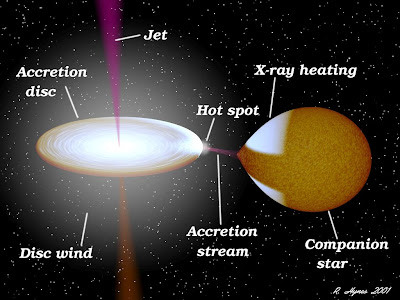 |
| Fig 1: Spectra of newly identified cataclysmic variables in the Kepler field-of-view |
This survey is my starting point to find new and interesting objects. To select both blue and H-alpha excess candidates I look at the colour-magnitude and colour-colour diagrams of the field. From these diagrams I have developed a computer code which finds the main stellar locus (where the majority of objects are, mostly main-sequence stars), and then locate objects which lie on the blue side of it and at the same time show clear H-alpha excess emission. Fig. 2 shows how this works graphically. On the left we have the colour-magnitiude diagram showing colour U-g on the x-axis and magnitude U in the y-axis. Blue object in this plot are to the left. The colour-colour diagram on the right shows r-i on the x-axis and r-Halpha on thr y-axis. Objects owning H-alpha excess are located to the top-left. All the red dots are the systems my computer code considers as candidates, and show both blue and H-alpha excess. Out of more than 900,000 objects from KIS data-release 1, about 500 are selected with this method. Although this selection is promising (we only retain 0.0005% of the whole sample), 500 objects are still quite a lot to follow up spectroscopically. Anyhow I applied to take spectra of the brightest ones with the William Herschel Telescope on La Palma, and to my amusement I got the time to do this. At the end of May 2012 I went there and observed the brighest 38 candidates down to a magnitude of 19 in the U band. Each spectrum required 30 minutes of exposure, which kind of explains why taking spectra of all 500 is not a realistic option in the short run. Anyhow, what I found, again to my amusment, was that I was able to discover 11 new cataclysmic variables in the Kepler field, and on top of that I found 13 new Quasars (high redshift Active Galactic Nuclei, also very interesting for timing studies). The identifications of my spectroscopic run are also summarised in Fig.2, where the big coloured points represent different classes explained in the caption (see also Scaringi et al 2012). After finding these I was eager to get Kepler to observe these targets and obtain lightcurves. To my further amusement I submitted a DDT proposal, and a few months ago I found out that indeed my targets will be observed! :) Now I can't wait to get my hands on those spectacular lightcurves Kepler is getting, but for that I will have to wait a bit, at least until the next Kepler data down-link scheduled sometime in January. In the mean time, I have culled more candidates in the last few days from the new KIS data release 2, and asked Anna Faye Mc Leod (my beautiful wife! :D ) and Thomas Kupfer (both at RU Nijmegen) to observe a few. It turns out that my selection criteria is working quite well, and many more cataclysmic variables are waiting to be found ;)
MV Lyrae using ULTRACAM on the WHT, but I think this will do for this post, and you'll have to wait for the next one before I tell you more about those observations (which by the way also have a high "coolness" factor! )
Ciao
Simo






